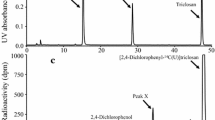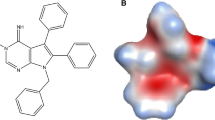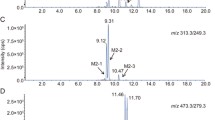Abstract
Thiocoraline is a potent new marine anti-cancer drug in vitro, which will be tested in phase I clinical studies shortly. To assess the biotransformation and the potential implications for human pharmacology and toxicology, the in vitro metabolism of thiocoraline was characterized using human plasma, human liver preparations, cytochrome P450 (CYP) and uridine diphosphoglucuronosyl transferase (UGT) supersomes and human cell lines.
Thiocoraline is significantly metabolized by enzymes present in human plasma; t 1/2 shifted from 25.2 h in phosphate buffered saline to 4.3 h in human plasma. Using CYP supersomes it was shown that thiocoraline is mainly metabolized by CYP3A4, with CYP1A1, CYP2C8 and CYP2C9 playing a minor role in the biotransformation (<3%). Only minor glucuronidation was observed for thiocoraline by UGT1A1 and UGT1A9 and no glucuronidation was observed in human liver S9 fraction. In addition, no glucosidation and sulfation were observed for thiocoraline in human liver cytosol and S9 fraction. However, the metabolites formed by cytochrome P450 were further conjugated by UGT, glutathione-S-transferase (GST) and sulfotransferase (ST). In contrast to the CYP metabolism observed in supersomes, no effect could be observed from the CYP3A4 inhibitors on the cytotoxicity of thiocoraline in Hep G2 cells. However, this could be due to low CYP expression levels in the Hep G2 and IGROV-1 cell line.
These results provide evidence that human CYP3A4 plays a major role in the metabolism of thiocoraline in vitro and that the metabolites formed by CYP are conjugated by the phase II enzymes UGT, ST and GST.
Similar content being viewed by others
References
Perez Baz J, Canedo LM, Fernandez Puentes JL, Silva Elipe MV: Thiocoraline, a novel depsipeptide with antitumor activity produced by a marine micromonospora II. Physico-chemical properties and structure determination. J Antibiotics 50(9): 738–741, 1997
Romero F, Espliego F, Perez Baz J, Garcia De Quesada T, Gravalos D, De La Calle F, Fernandez Puentes JL: Thiocoraline, a new depsipeptide with antitumor activity produced by a marine micromonospora I. Taxonomy, fermentation, isolation and biological activities. J Antibiotics 50(9): 734–737, 1997
Erba E, Bergamaschi D, Ronzoni S, Faretta M, Taverna S, Bonafanti M, Catapano CV, Faircloth G, Jimeno J, D’Incalci M: Mode of action of thiocoraline, a natural marine compound with anti-tumour activity. Br J Cancer 80(7): 971–980, 1999
Faircloth G, Jimeno J, D’Incalci M: Biological activity of thiocoraline, a novel marine depsipeptide. Eur J Cancer 33: 175, 1997 (abstract)
Sparidans RW, Henrar REC, Jimeno JM, Faircloth G, Floriano P, Beijnen JH: Bioanalysis of thiocoraline, a new marine antitumoral depsipeptide, in plasma by high-performance liquid chromatography and fluorescence detection. J Chromatogr B 726(1/2): 255–260, 1999
Sassa S, Sugita O, Galbraith RA, Kappas A: Drug metabolism by the human hepatoma cell, Hep G2. Biochem Biophys Res Communications 143(1): 52–57, 1987
Doostdar H, Burke MD, Melvin WT, Grant MH: The effects of dimethylsulphoxide and 5-aminolevulinic acid on the activities of cytochrome P450-dependent mixed function oxidase and UDP-glucuronosyltransferase activities in human Hep G2 hepatoma cells. Biochem Pharmacol 42(6): 1307–1313, 1991
Fardel O, Morel F, Ratanasanh D, Fautrel A, Beaune P, Guillouzo A: Expression of drug metabolizing enzymes in human HepG2 hepatoma cells. Cellular MolecAspects Cirrhosis 216: 327–330, 1992
Rueff J, Chiapella C, Chipman JK, Darroudi F, Duarte Silva I, Duverger-van Bogaert M, Fonti E, Glatt HR, Isern P, Laires A, Leonard A, Llagostera M, Mossesso P, Natarajan AT, Palitti F, Rodrigues AS, Schinoppi A, Turchi G, Werle-Schneider G: Development and validation of alternative metabolic systems for mutagenicity testing in short-term assays. Mutation Res 353(1/2): 151–176, 1996
Sumida A, Fukuen S, Yamamoto I, Matsuda H, Naohara M, Azuma J: Quantative analysis of constitutive and inducable CYPs mRNA expression in the HepG2 cell line using reverse transcription-competitive PCR. Biochem. Biophys Res Commun 267(3): 756–760, 2000
Sparidans RW, Rosing H, Hillebrand MJX, López-Lázaro L, Jimeno JM, Manzanares I, van Kesteren C, Cvitkovic E, van Oosterom AT, Schellens JHM, Beijnen JH: Search for metabolites of ecteinascidin 743, a novel, marine-derived, anticancer agent, in man. Anti-Cancer Drugs 12(8): 653–666, 2001
Gentest, a BD Biosciences Company. http://www.gentest.com/ (accessed March 2002)
Gentest Cytochrome P450 database. http://www.gentest.com/human_p450_database (accessed January 2001)
Higgins JD III, Neely L, Fricker S: Synthesis and cytotoxicity of some cyclometallated palladium complexes. J Inorganic Biochemistry 49(2): 149–156, 1993
Whrighton SA, Stevens JC: The human hepatic cytochromes P450 involved in drug metabolism. Crit Rev Toxicol 22(1): 1–21, 1992
Smith DA, Jones BC: Commentary: Speculations on the structure-activity relationship (SSAR) of cytochrome P450 enzymes. Biochem Pharmacol 44: 2089–2098, 1991
Wilkinson GR: Cytochrome P4503A (CYP3A) metabolism: Prediction of in vivo activity in humans. J Pharmacokinet Biopharm 24(5): 475–490, 1996
MacLeod SL, Nowell S, Massengill J, Jazieh A, McClure G, Plaxco J, Kadlubar FF, Lang NP: Cancer therapy and polymorphisms of cytochromes P450. Clin Chem Lab Med 38(9): 883–887, 2000
Tanaka E: Gender-related differences in pharmacokinetics and their clinical significance. J Clin Pharm Ther 24(5): 339–346, 1999
Patterson LH, McKeown SR, Robson T, Gallagher R, Raleigh SM, Orr S: Antitumour prodrug develepment using cytochrome P450 (CYP) mediated activation. Anticancer Drug Des 14(6): 473–486, 1999
Wormhoudt LW, Commandeur JNM, Vermeulen NPE: Genetic polymorphisms of human N-acetyltransferase, cytochrome P450, glutathione-S-transferase, and epoxide hydrolase enzymes: Relevance to xenobiotic metabolism and toxicity. Critical Rev Toxicol 29(1): 59–124, 1999
Nishiyama T, Ogura K, Nakano H, Ohnuma T, Kaku T, Hiratsuka A, Muro K, Watabe T: Reverse geometrical selectivity in glucuronidation and sulfation of cis-and trans-4-hydroxytamoxifens by human liver UDP-glucuronosyltransferases and sulfotransferases. Biochem Pharmacol 63(10: 1817–1830, 2002
Miners JO, MacKenzie PI: Drug glucuronidation in humans. Pharmac Ther 51(3): 347–369, 1991
Grant H, Duthie SJ, Gray AG, Burke D: Mixed function oxidase and UDP-glucuronyltransferase activities in the human Hep G2 hepatoma cell line. Biochem Pharmacol 37(21):4111–4116, 1988
Ferretti A, D’Ascenzo S, Knijn A, Iorio E, Dolo V, Pavan A, Podo F: Detection of polyol accumulation in a new ovarian carcinoma cell line, CABA I: a(1)H NMR study. Br J Cancer 86(7): 1180–1187, 2002
Perego P, Paolicchi A, Tongiani R, Pompella A, Tonarelli P, Carenni N, Romanelli S, Zunino F: The cell-specific anti-proliferative effect of reduced glutathione is mediated by gamma-glutamyl transpeptidase-dependent extracellular pro-oxidant reactions. Int J Cancer 71(2): 246–250, 1997
Curry SH: Drug disposition and pharmaconkinetics with a consideration of pharmacological and clinical relationships. Blackwell Scientific Publications 2: 42–48, 1974
Gibson GG, Skett P: Introduction to drug metabolism. Blackie Academic and Professional 1: 1–34, 1995
Author information
Authors and Affiliations
Rights and permissions
About this article
Cite this article
Brandon, E.F.A., Sparidans, R.W., Meijerman, I. et al. In vitro characterization of the biotransformation of thiocoraline, a novel marine anti-cancer drug. Invest New Drugs 22, 241–251 (2004). https://doi.org/10.1023/B:DRUG.0000026250.34645.7f
Issue Date:
DOI: https://doi.org/10.1023/B:DRUG.0000026250.34645.7f




